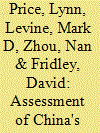| Srl | Item |
| 1 |
ID:
103348


|
|
|
|
|
| Publication |
2011.
|
| Summary/Abstract |
From 1980 to 2002, China experienced a 5% average annual reduction in energy consumption per unit of gross domestic product (GDP). With a dramatic reversal of this historic relationship, energy intensity increased 5% per year during 2002-2005. China's 11th Five Year Plan (FYP) set a target of reducing energy intensity by 20% by 2010. This paper assesses selected policies and programs that China has instituted to fulfill the national goal, finding that China made substantial progress and many of the energy-efficiency programs appear to be on track to meet - or in some cases exceed - their energy-saving targets. Most of the Ten Key Projects, the Top-1000 Program, and the Small Plant Closure Program will meet or surpass the 11th FYP savings goals. China's appliance standards and labeling program has become very robust. China has greatly enhanced its enforcement of new building energy standards but energy-efficiency programs for buildings retrofits, as well as the goal of adjusting China's economic structure, are failing. It is important to maintain and strengthen the existing energy-saving policies and programs that are successful while revising programs or adding new policy mechanisms to improve the programs that are not on track to achieve the stated goals.
|
|
|
|
|
|
|
|
|
|
|
|
|
|
|
|
| 2 |
ID:
099210


|
|
|
|
|
| Publication |
2010.
|
| Summary/Abstract |
From 1970 to 2001, China was able to significantly limit energy demand growth through aggressive energy-efficiency programs. Energy use per unit of gross domestic product (GDP) declined by approximately 5% per year during this period. However, the period 2002-2005 saw energy use per unit of GDP increase an average of 3.8% per year. To stem this out-of-control growth in energy demand, in November 2005 the Chinese government enunciated a mandatory goal of 20% reduction of energy intensity between 2006 and 2010. The National People's Congress passed legislation identifying the National Reform and Development Commission as the lead agency to design and carry out programs in support of this goal. These policies and programs, created after almost a decade of decline of the energy-efficiency policy apparatus, have had considerable impact. Although initial efforts have not been sufficient to meet the annual declines required to reach the ambitious 20% energy intensity target, the latest reports indicate that China may now be on track to meet this goal. The paper provides an assessment of these policies and programs to begin to understand issues that will play a critical role in China's energy and economic future. Activities undertaken in China will have a significant influence on the global effort to reduce the growth, and later the absolute quantity, of greenhouse gas emissions.
|
|
|
|
|
|
|
|
|
|
|
|
|
|
|
|